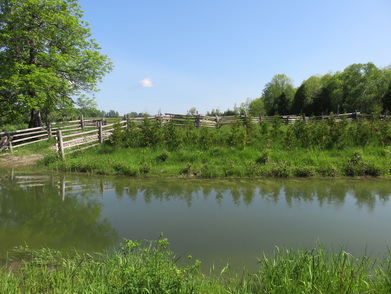Mindemoya River - MIN-302, MIN-304 & MIN-306

Cattle Restriction, Rehabilitation and Enhancement
Sites MIN 302, 304 and 306 had extensive erosion and lack of canopy due to improper land use practices and unrestricted livestock access. Fluctuating water levels also undermined the stability of the banks creating large amounts of erosion and sediment discharge. In order to rehabilitate these 3 adjoining sites, bio-engineered site designs were created to prevent further erosion and sediment discharge. The above mentioned methods coupled with the installation of fencing and a designated livestock crossing/watering area, which will restrict livestock access to the banks and watercourse accomplishes two goals in the enhancement strategy. Large excavators were used to grade the vertical eroding banks back to a 2:1 slope. The resulting banks were vegetated with native grasses and tree/shrub species. A rock chute was installed on MIN 302 to allow for proper drainage and a designated livestock crossing with angled cobble and fencing installed at MIN 306 to prevent further erosion. Geo-textile and a large angled rock toe was created at the base of the banks to absorb the rivers energy and provide some much needed in-stream habitat. Fencing was also installed to keep livestock clear of the stream.
The rehabilitation of sites MIN 302, 304 and 306 involved the installation of the following fish habitat features along an approximately 83m long section of the Mindemoya River.
MIN 302
Rehabilitation of an approximately 25m long section of the Mindemoya River including the supply and installation of:
MIN 304
Rehabilitation of an approximately 23m long section of the Mindemoya River including the supply and installation of:
MIN 306
Rehabilitation of an approximately 35m long section of the Mindemoya River including the supply and installation of:
Overall – MIN 302, 304, 306
This project had 4 OMNR Manitoulin Area Stewardship Rangers and 1 leader who put in 80 hours worth of work. This project also had 21 OMNR Stewardship Rangers from Killarney Provincial Park and 3 leaders who put in 384 hours worth of work. Another 2 volunteers logged approximately 16 hours, running the chainsaw and planting trees.
This project had 7 volunteers from the Board of Directors of Manitoulin Streams participate in planning and actively volunteering at rehabilitation sites. The total number of hours volunteered for this site is 51.4 hours.
The landowner contributed 15 hrs of labour and 5 hrs of attending meetings and the in-kind support included supplying materials and fence rails 157 meters, as well as advice on and installation of the electric fence. The landowner also took the Environmental Farm Plan course and applied for funding for this project.
Funding contributions toward the construction of the project include CFWIP, COA and NOHFC.
Sites MIN 302, 304 and 306 had extensive erosion and lack of canopy due to improper land use practices and unrestricted livestock access. Fluctuating water levels also undermined the stability of the banks creating large amounts of erosion and sediment discharge. In order to rehabilitate these 3 adjoining sites, bio-engineered site designs were created to prevent further erosion and sediment discharge. The above mentioned methods coupled with the installation of fencing and a designated livestock crossing/watering area, which will restrict livestock access to the banks and watercourse accomplishes two goals in the enhancement strategy. Large excavators were used to grade the vertical eroding banks back to a 2:1 slope. The resulting banks were vegetated with native grasses and tree/shrub species. A rock chute was installed on MIN 302 to allow for proper drainage and a designated livestock crossing with angled cobble and fencing installed at MIN 306 to prevent further erosion. Geo-textile and a large angled rock toe was created at the base of the banks to absorb the rivers energy and provide some much needed in-stream habitat. Fencing was also installed to keep livestock clear of the stream.
The rehabilitation of sites MIN 302, 304 and 306 involved the installation of the following fish habitat features along an approximately 83m long section of the Mindemoya River.
MIN 302
Rehabilitation of an approximately 25m long section of the Mindemoya River including the supply and installation of:
- bank grading
- rock chute
- rock fill complete with underlying geotextile along the toe of bank grading
- riparian vegetation and canopy
- implementation of an erosion and sediment control plan
MIN 304
Rehabilitation of an approximately 23m long section of the Mindemoya River including the supply and installation of:
- bank grading
- rock fill complete with underlying geotextile along the toe of bank grading
- riparian vegetation and canopy
- implementation of an erosion and sediment control plan
MIN 306
Rehabilitation of an approximately 35m long section of the Mindemoya River including the supply and installation of:
- bank grading
- rock fill complete with underlying geotextile along the toe of bank grading
- riparian vegetation and canopy
- cattle access ramps and fencing
- implementation of the erosion and sediment control plan
- A total of 180 linear meters in shoreline and riparian linear length blocked from livestock access.
Overall – MIN 302, 304, 306
- A total of 498 m2 of in stream habitat rehabilitated.
- 4,320 m2 total riparian and canopy area created. (Average of 12 linear meters riparian area fenced off)
- 256 linear m of new split cedar rail fencing installed to restrict cattle access to river. (landowner supplied older rails to fill in remainder)
- 80 linear m of electric fencing installed to restrict cattle access to river. Electric fence area was fenced off to leave room for equipment to enter in potential 2011 project.
This project had 4 OMNR Manitoulin Area Stewardship Rangers and 1 leader who put in 80 hours worth of work. This project also had 21 OMNR Stewardship Rangers from Killarney Provincial Park and 3 leaders who put in 384 hours worth of work. Another 2 volunteers logged approximately 16 hours, running the chainsaw and planting trees.
This project had 7 volunteers from the Board of Directors of Manitoulin Streams participate in planning and actively volunteering at rehabilitation sites. The total number of hours volunteered for this site is 51.4 hours.
The landowner contributed 15 hrs of labour and 5 hrs of attending meetings and the in-kind support included supplying materials and fence rails 157 meters, as well as advice on and installation of the electric fence. The landowner also took the Environmental Farm Plan course and applied for funding for this project.
Funding contributions toward the construction of the project include CFWIP, COA and NOHFC.

